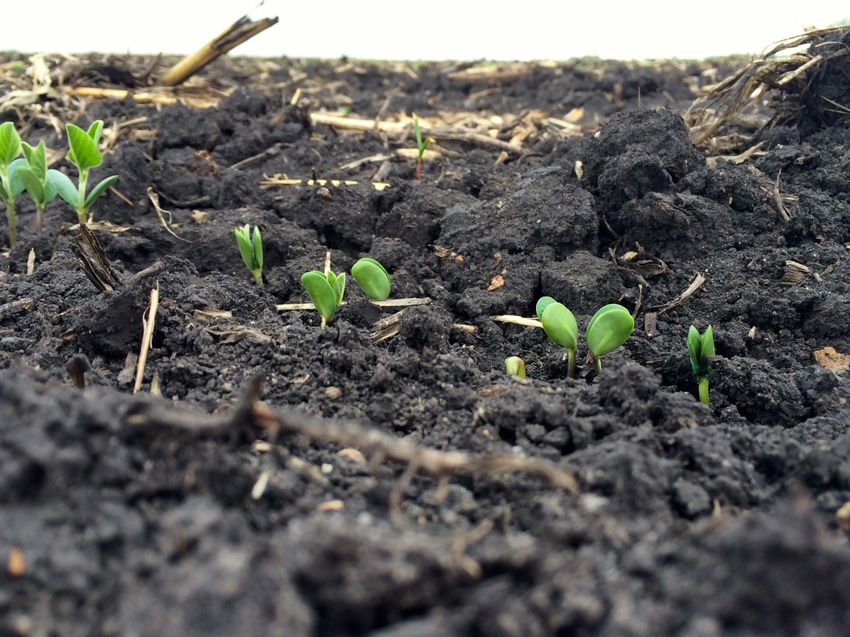
5 tips for best soybean yields
How do you you get the best soybean yields? Reasearch. Illinois farmer Marion Calmer has tested practices on his soybean crops to help increase yields, and some of those are just basics for growing soybeans. From no-till and narrow rows, soybean fertilizer and seeding rates, these practices have helped Calmer increase soybean yields.
August 26, 2013

Marion Calmer has done independent, on-farm research for nearly 30 years. With more than 300 research plots on his farm, the Alpha, Ill., corn and soybean farmer has tested – and continues to test – practices to break through his soybean-yield barrier. Five have risen to the top. “You can't improve on things you don't measure,” he says.
"During the mid-1980s, my soybean yields averaged in the mid- to upper 40 bushels per acre," he says. “I have added about 20 bushels to the acre. The goal, naturally, is to shoot for 100 bushels, if it’s economical."
Here are his top five yield-busting tools:
1. Switch to no-till. After realizing in the 1980s that conventional tillage was not going to meet his long-term environmental goals, Calmer no-tilled soybeans. Before that, soybeans had been one of the most soil-erosive crops he had ever grown, he says.
"I started no-tilling beans into cornstalks. No-till requires trying different things to see what will work on your farm. If you keep a positive attitude, you can make it work," he says. "No-till really helped my yields during a dry 2012."
2. Narrow rows. Calmer also started planting corn in 15-inch rows in 1995. He adjusted his row cleaner at planting until he was able to pull residue from one row without throwing it into the next row. He has not touched his equipment settings since about 1998. The residue cover is uniform and provides a good environment for corn and soybeans to emerge in the spring.
He compared 30-inch to 15-inch rows in the 2008-2011 seasons, using the same planter, variety and inputs. He planted four replications per year for a total of 16 replications. The average response in changing to 15-inch rows was a 4-bushel yield increase per acre. The 2012 difference was even more.
"With the drought, we increased yield from 60 to 66 bushels per acre in 15-inch rows, or $72 more per acre," he says. "I believe there is still room for improvement."
3. Apply dry fertilizer (P&K). Calmer sees a return on investment to spreading P and K. He follows University of Illinois guidelines for balancing his pH with lime applications each year. Last season, after not using P or K for about a decade, he applied about $50 worth of P and K per acre, based on soil-test results. Soybean yields averaged 59 bushels per acre.
"We only picked up 4 bushels an acre, which was breakeven with $12 beans," he says. "The results did not tell me to spread or not to spread, but they did confirm I might be able to get a better response by adjusting the application, placement or amount. Without measuring (results), I would not have reached this conclusion. P and K are not current limiting factors in breaking my yield barrier."
Surface applications and stratification may be the problem, Calmer says, so he evaluates micronutrients and root-zone band applications. "The yield kick has to be better than 4 bushels per acre to make it work," he says.
4. Lower seeding rates. Calmer used to drill 200,000 soybean seeds in 15-inch rows. He first dropped that to 150,000, or four seeds per foot of row. For the last five years, he has planted 75,000, or two seeds per foot of row, and is seeing more pods per plant. He always plants treated seed.
"Our five-year average of planting 50,000 and adding to that in 25,000 increments up to 200,000 found only a one bushel per acre increase in 20 replications when we went from 50,000 to 75,000. Over 100,000, yield flattens and the variety does not respond to population," he says. "I have planted 75,000 for the last five years, which is where I maximize profit."
Even so, Calmer says he would have been better planting 150,000 in 2012. His plots at 50,000 population yielded 59 bushels per acre, and at 150,000 yielded 63 bushels per acre.
"I left some money on the table – about $35 per acre, but you can't predict a drought," he says. "For most years, if you buy more seed, you lose money and are at risk of white mold."
5. Manage residue. Calmer finds managing residue not only is an environmental benefit, but an economic one. "We are seeing heavier rains earlier in the season than we used to, and less rain in the summer months. That heavy rain takes the corn stalks and plugs culverts," he says. "Plus the Bt corn we plant now has a higher yield, but also stronger stalks that are hard to decompose."
Calmer has experimented with corn heads to find ways to better chew up stalks and feed worms and microbes. He also evaluates how he cuts soybeans to throw the chaff for even distribution.
"I will look at cover crops in the future as a way to manage residue over winter," Calmer says. "This year, I have research plots to evaluate corn populations. In soybeans, I am still monitoring populations and also how late planted beans respond to different populations."
About the Author(s)
You May Also Like



